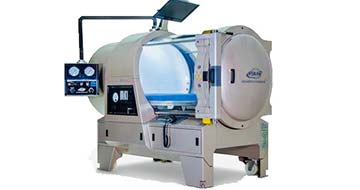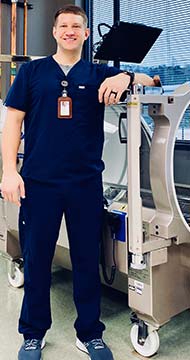Wound Care at Brookwood Baptist Medical Center
Mar 12, 2020Diabetes, immobilization or circulatory problems are just a few ways that people get chronic wounds. Wounds that don’t heal properly can quickly escalate from being a nuisance to a serious health threat.
The caring physicians at Brookwood Baptist Health guide you through every step of the healing process. One of the ways this takes place is through our hyperbaric chamber. We sat down with Josh Mincy, certified hyperbaric technologist (CHT) and safety director at Brookwood Baptist Medical Center, and he answered some questions we had on wound care and the hyperbaric chamber.
Q: What is a hyperbaric chamber?
 A: A hyperbaric chamber is used to perform Hyperbaric Oxygen Therapy (HBOT) on patients in need of pressurized 100% oxygen. The type of chamber pictured above is a Pahi “monoplace” chamber, meaning it is intended for single human occupancy. Brookwood's Pahi chamber is capable of treating patients at pressure equivalents felt while scuba diving down to 66 FSW (feet of seawater.)
A: A hyperbaric chamber is used to perform Hyperbaric Oxygen Therapy (HBOT) on patients in need of pressurized 100% oxygen. The type of chamber pictured above is a Pahi “monoplace” chamber, meaning it is intended for single human occupancy. Brookwood's Pahi chamber is capable of treating patients at pressure equivalents felt while scuba diving down to 66 FSW (feet of seawater.)
- Hyperbaric Oxygen Therapy (HBOT) is a medical treatment providing 100% oxygen under pressure to a patient. The use of pressure in a hyperbaric chamber allows cells within the body, that normally receive only 21% or less, to receive 100% oxygen. This surge of oxygen under pressure gives the body’s damaged/dying cells the ability to heal through angiogenesis, or the development of new blood vessels.
- Hyperbaric Oxygen Therapy is a safe and effective treatment with little to no side effects lasting for any significant period of time. Some patients might find themselves with difficulty seeing further away (myopia) and increased ability to see closer object. These effects are mild and short-lived lasting only days-weeks following the final treatment.
Q: What conditions can the chamber treat?
A: The following indications are approved (covered by insurance) uses of HBOT:
- Air or gas embolism
- Carbon monoxide poisoning
- Carbon monoxide poisoning complicated by cyanide poisoning
- Clostridial myositis and myonecrosis (gas gangrene)
- Crush injury, Compartment Syndrome and other acute traumatic ischemia
- Decompression sickness
- Arterial insufficiencies
- Central retinal artery occlusion
- Enhancement of healing in selected problem wounds
- Severe anemia
- Intracranial abscess
- Necrotizing soft tissue infections
- Osteomyelitis (refractory)
- Delayed radiation injury (soft tissue and bony necrosis)
- Compromised grafts and Flaps
- Acute thermal burn injury
- Idiopathic sudden sensorineural hearing loss
Reference:
https://www.uhms.org/resources/hbo-indications.html
Other uses of hyperbaric oxygen therapy are referred to as “off-label” treatments. These are treatments not covered by insurance for various reasons including overall expense to Medicare, inability to conduct double-blind studies, and lack of sufficient research. Hospitals refrain from treatment of off-label indications as they are not covered by insurance. Off-label treatments must be obtained from specifically designated off-label clinics and are paid 100% out of pocket. Many people have found successful outcomes in off-label treatments for the following conditions:
- Traumatic Brain Injuries
- Stroke
- Dementia
- Autism
- Bell’s Palsy
- Bone fractures
- Sports Injuries: concussion, spinal cord, muscle
Q: What’s the most common thing you all see people coming in for?
A: Soft tissue radiation injuries that result in chronic/non-healing wounds

Shown is Josh Mincy, MBA. NRP. CHT, in front of the hyperbaric chamber at Brookwood Baptist Medical Center.
We asked Josh more questions about the Chamber. Click here to read the second installment of our chat with Josh.
